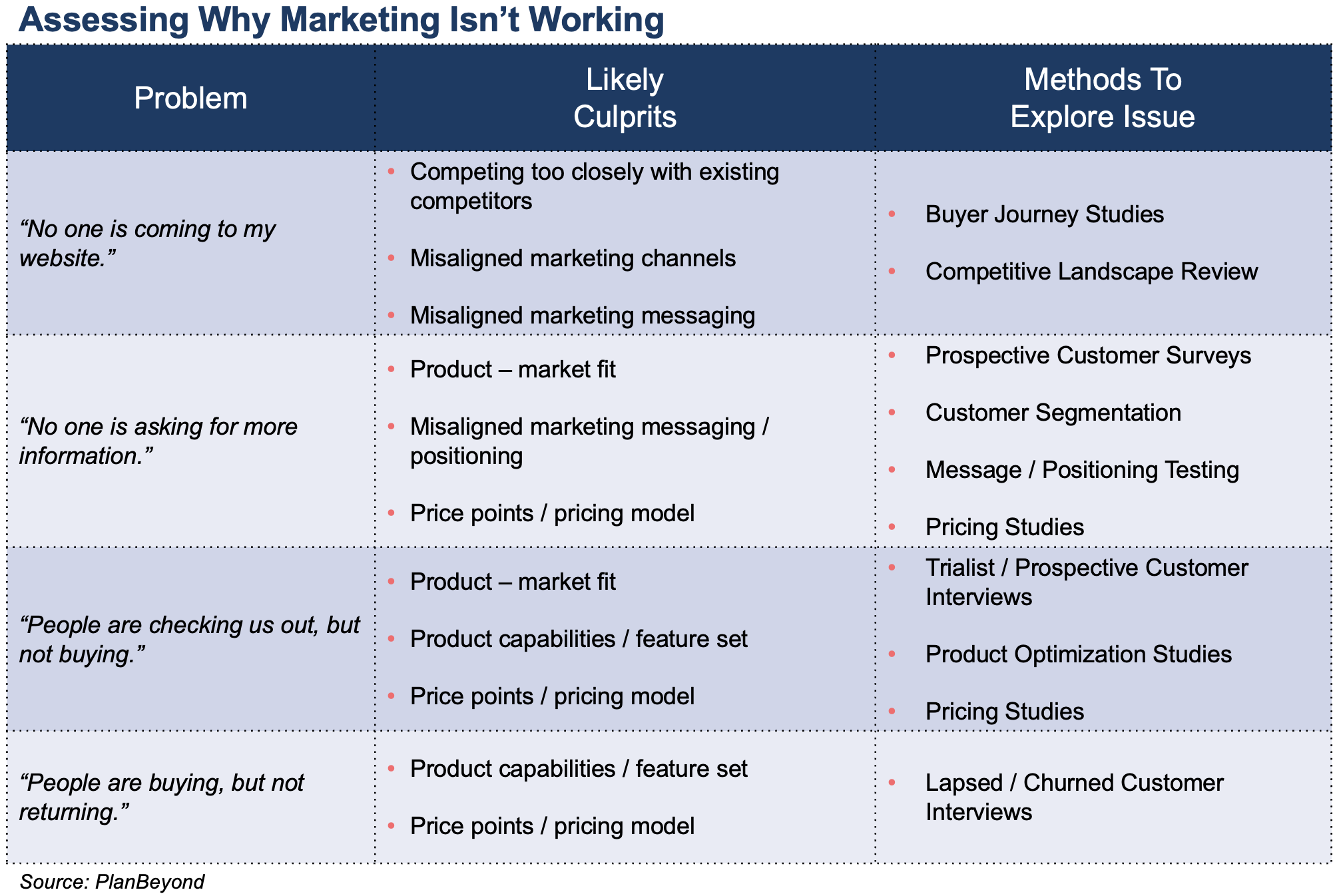It’s tempting to point to insufficient funds as the reason why your marketing isn’t working. Just spend a little more and your problems are solved. Right? Wrong!
Going down this path likely means throwing good money after bad.
This is because so much has to go right to get a new customer. First they need to know you exist. Then they need to explore your product or service. Following this, they need to decide if you’re the one they want and if they’re willing to pay. Lastly, they need to keep coming back. If your marketing isn’t working, more money won’t fix the problem.
Instead, explore each stage in the buyer journey. Applying classic market research methods to each stage pinpoints the biggest marketing problem areas, and therefore how to solve your marketing woes.
Typical Areas Where Your Marketing Isn’t Working
When working with our clients, we first ask them which of the problem statements below best fits their challenges. By understanding where the problem area lies, we have a general sense for the core areas where their marketing isn’t working.

Problem Statement #1: No One Is Coming To My Website
When we hear this comment, we know there’s likely a broader awareness issue at play. That is, people who you think should know about you and be checking you out aren’t.
Several issues could factor into why awareness marketing isn’t working. It could be that our client is trying to mimic a competitor, and failing to get noticed. Or, it could be that the marketing channels they’re using aren’t where their customer is. Lastly, another typical challenge is poor messaging. That is, using positioning, value propositions, or claims that simply don’t resonate with a target audience.
Problem Statement #2: No One Is Asking For More Information
This statement tells us people are looking, but something about what they see does not meet their needs or expectations. At this point, we have a lot of potential culprits.
A common issue is product-market fit. That is, the product itself does not meet an existing need or demand among the customer set you targeted. Another factor at this stage may not be the product but rather the messaging. Perhaps there is a strong product-market fit, but the positioning or benefits touted do not align with customer needs. Lastly, the price or pricing model may be off. Customers may expect a less expensive product, or they may not perceive that the product has a strong enough value for the price.
Problem Statement #3: People Are Checking Us Out, But Not Buying
When we hear this phrase, we know the top-of-funnel marketing is probably working. This leads us to look at product and pricing as likely culprits.
It could be that the product did not actually meet the needs of the market. This could mean the product itself requires updates or the target customer is off. Or, prospective customers may like the product experience, but do not see it as worth the price. This points to a price or perceived value issue.
Problem Statement #4: People Are Buying But Not Returning
Just about every business wants to retain its customers. As a result, when we hear this phrase, we know the broader issue is around the end product experience not meeting expectations. Again, this could point to feature – functionality issues with the product itself. Or, customers may not consider the price to be worth it.
How To Uncover The Core Reasons Your Marketing Isn’t Working
Once you identify where your marketing isn’t working, you can then jump into problem identification.
Let’s look at our list of potential culprits and explore how we uncover if, in fact, they are the issues at play.
- Undifferentiated Marketing: If competing too closely with competitors seems like the issue, perform a competitive landscape review. This involves looking at how you and competitors stack up across messaging, pricing, marketing tactics and much more. These reviews let you visualize where similarities lie, and opportunities to differentiate yourself.
- Poor Marketing Channel Mix: A common marketing problem is not advertising in the places where your customer is. Performing a buyer journey study lets you assess how customers learn about, and evaluate, products in your category. This shows what marketing tactics you should invest in to be front and center.
- Product – Market Fit: Are you concerned that your product or its features may not be quite right for your market? Ask! Use customer interviews to understand key pain points and customer needs. You can also use these interviews to ask specific questions about your product and its features. This type of direct feedback uncovers ways you’ll need to adjust your product or market targeting to build greater interest.
- Messaging & Positioning: Sometimes the way we talk about a product is actually the problem, not the product itself. Use message testing to uncover evolutions in brand tenants or value props needed to drive stronger market resonance.
- Product Feature Set: Unfortunately, sometimes the product is the problem. There are whole host of ways to identify if this is a problem. Depending on the potential issues, leverage product optimization studies or traditional interviews to determine what the market really needs in your product.
- Pricing: Customers have to be willing to buy your product. If it looks like the price point or pricing model may be a problem, it’s time for pricing research. This helps pinpoint ideal price points as well as disconnects between price and perceived value.
Prioritizing What To Work On First
What do you do if you find yourself with more than one of these problems? Assuming you are a resource-constrained organization, you have to prioritize which initiative to work on first. Here are two ways we often recommend prioritizing issues:
- Prioritize The Biggest Conversion Drop Offs: Look at what percentage of people make it to the next stage in the buyer journey. For instance, if 10 trialists out of 100 converted to being paid customers, you have a 10% conversion rate. Look at industry benchmarks to see how you stack up. If your conversion rates line up well, great. Prioritize a different issue. But, if they are well below average, that’s a signal that it may be time to work on that particular stage.
- Prioritize Bottom-Of-The-Funnel Stages First: Another approach prioritizes retention and customer conversion stages first. This school of thought recognizes how hard it is to close a new customer. As a result, improving these stages has an immediate revenue impact on your business. Additionally, it means any future work done on top-of-funnel activities yields stronger long-term results.
Look at your particular business needs and dynamics to choose the right option. But yes, to really address the underlying reasons why your marketing isn’t working, you do need to choose.






